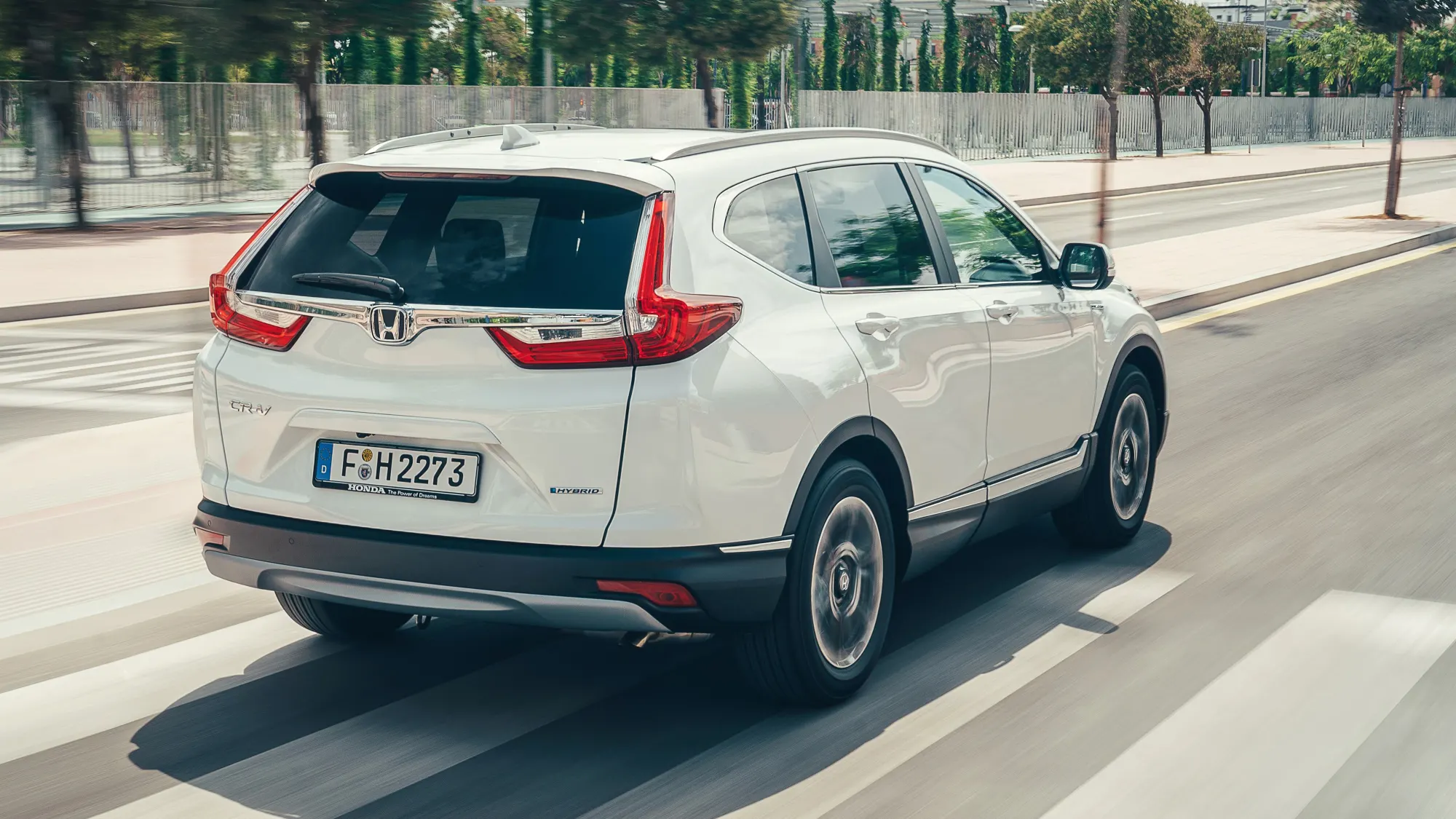Honda CR-V Hybrid This is how it did in the long-term test; The thirsty turbo petrol engine is history: the Honda CR-V is only available with an extraordinary hybrid drive. He had to enter the ADAC test with him – and then prove himself in the endurance test.
- The domain of the Honda CR-V Hybrid is cruising
- Generous space for a relaxed journey
- In practice, consumption is six liters
This car has hardly made headlines so far. The model has been around for more than 25 years: Honda has been offering the CR-V SUV since 1996, for a long time only with a rather thirsty 2.0-liter petrol engine. Only in 2004 did Honda add an economical diesel engine to its range. Only one hybrid version is now available, with a choice of front-wheel or all-wheel drive.
The task is therefore clear: the hybrid drive with the e:HEV abbreviation known from Jazz must be measured against its claim to reduce fuel consumption, as with diesel. If he does not succeed in practice, the complex technology makes little sense. But can the Honda CR-V Hybrid live up to the claim?
The Honda CR-V Hybrid in the ADAC test
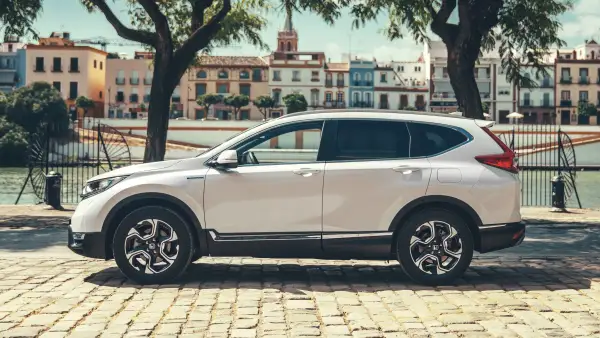
Hybrid drives are characterized by the fact that a small but very efficient electric motor supports the significantly larger and more powerful but inefficient internal combustion engine and thus reduces fuel consumption. The energy for the small electric motor when braking and decelerating falls as a by-product. The technical term for this is recuperation. The braking energy gained is stored in a battery and retrieved when required. In principle, this works well in practice, as the Toyota Prius, a hybrid pioneer, has proven for many years.
In the case of the Honda CR-V Hybrid, however, the ratio of main and auxiliary drive was reversed. With 135 kW/184 hp, the e-machine in the Honda has significantly more power than the combustion engine, which provides a maximum of 107 kW/146 hp. The idea behind it: The e-machine should be responsible for driving the wheels, the combustion engine for providing the required energy. Of course, the Honda also takes the resulting recuperation energy with it.
Honda technician Kotaro Yamamoto explains the concept: “We decouple the petrol engine from the wheels. This means we can always let it work in the range of its most fuel-efficient operating point. That has advantages.” That’s the theory.
Honda CR-V Hybrid: Three operating states
In practice, one can distinguish between three operating states of the Honda CR-V e:HEV. On the one hand, electric driving without the combustion engine running: This happens when the load requirement is low, for example when the car is being driven in the city. However, the energy reserve in the battery is very limited at 1.5 kWh, so that only short distances can be driven exclusively with the e-machine and power from the battery. The “EV Drive” does not differ from that of a usual hybrid vehicle.
The second mode of operation of the Honda CR-V Hybrid kicks in when the energy in the battery is running low – especially when there is an increased demand for power for rapid acceleration and at high speeds on the freeway. In this operating state – and this is the crucial difference – the combustion engine drives solely the integrated generator to generate electricity. The combustion engine is running, but the car still drives purely electrically. Honda calls this operating mode “Hybrid Drive“.
Thirdly – and now it’s getting more complicated – there is another operating condition in which the combustion engine is directly connected to the drive axle via a clutch, while the electric motor is decoupled. Now the drive is completely taken over by the combustion engine. The electric traction machine is at rest.
This third operating mode, which Honda calls “Engine Drive“, only occurs when the load requirement corresponds almost exactly to the power that the combustion engine delivers at its so-called best point. Because the Honda doesn’t have a transmission, that’s when the car is gliding between 80 and 120 km/h.
At higher speeds, the system reverts to the second operating mode, the hybrid mode: the electric motor takes over the traction, the combustion engine provides the power.
The drive changes constantly in the CR-V
And so a constant back and forth takes place, which is automatically carried out by the hybrid system based on defined energy parameters: Sometimes the electricity from the generator goes into the battery, sometimes directly to the electric motor. And again and again, the flow of electricity is split between the drive and storage. When looking at the energy flow display, the driver can sometimes get dizzy.
Apart from the occasional roar of the engine, the driver hardly notices these constant changes in drive mode. Shifting and jerking in the drive train? none. Interior noise is also pleasantly low when gliding along in the CR-V Hybrid. Only under increased load does the petrol engine start to make noise.
CR-V Hybrid: everyday experiences of the editors
I like big cars, at least if they’re not gas guzzlers. Fortunately, the Honda is not, thanks to its hybrid drive. So I enjoy the advantages with a clear conscience: the generous amount of space, also on the back seat, and the trunk with plenty of room for the big shopping on Saturday. The view of the traffic is excellent thanks to the high seating position.
Oddly enough, the Honda is still confusing. I notice this especially when parking in tight parking spaces in the city center – even if the reversing camera makes life as much easier as possible. When accelerating, these points of criticism are immediately forgotten: the car then pushes powerfully. However, not exactly noiseless. When depressing the gas pedal on the Autobahn, it sounds annoyingly like howling buoys. But I forgive the Honda for that. It’s just a very big and lively car. I think that’s wonderful.
Chic, very large and spacious – that was the first impression of the Honda CR-V when it was supposed to drive two people hungry for wellness to Tyrol. Even the junior (4), who immediately wanted to go for a spin after seeing it at first sight, finds plenty of space with the child seat and even seems a bit lost in the back seat.
Test consumption: Around 6.5 liters per 100 kilometers
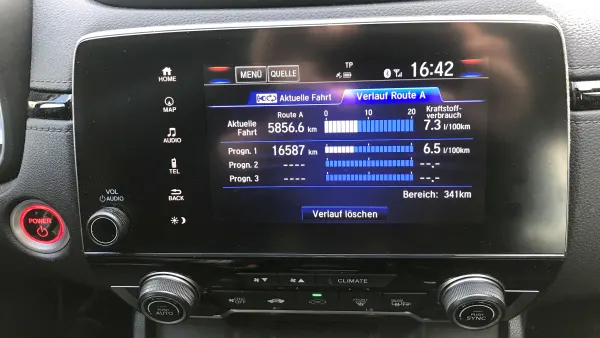
While Honda states a WLTP consumption of 6.6 liters in the brochures, the daily consumption in the editorial office even leveled off at only around 6.5 liters Super per 100 kilometers driven. here were, of course, individual differences. As a commuter vehicle between the Munich ADAC headquarters and the surrounding area, the Honda consumed 6.7 liters, and 5.9 liters purely in city traffic. Brisk autobahn tours in Germany cost nine to ten liters. In speed-limited countries, the editors usually drove a value under six liters.
The results agree surprisingly well with the ADAC Ecotest values determined under the same test conditions on the test bench: 5.5 liters in the city, 6.0 on the country road and 9.6 liters on the motorway. Average consumption: 7.0 liters Super per 100 kilometers. For a large and heavy SUV, these are actually remarkably good values.
For comparison: The no longer offered, purely petrol-powered CR-V – a four-cylinder turbo petrol engine with 142 kW/193 hp and 243 Nm torque – had a consumption of 8.9 liters Super per 100 kilometers in the ADAC Ecotest – almost two liters more !
Powerful electric motor with 184 hp
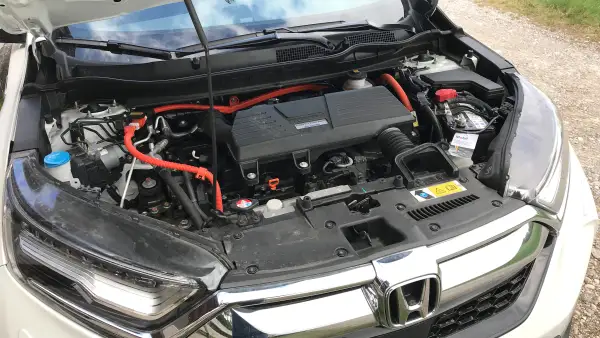
If you don’t mind the noise level, you can even build on reasonably sporty driving performance. The electric motor in the CR-V Hybrid delivers an impressive 184 hp and develops 315 Nm of torque from a standing start. This accelerates the Honda CR-V Hybrid from zero to 100 km/h in 8.6 seconds, at 180 km/h it’s the end. In Sport mode, the power of the drive unfolds even more directly and spontaneously than in Eco mode, where the system limits the use of energy.
Honda CR-V Hybrid: Very good space

The Honda CR-V shows outstanding qualities in terms of space. In particular, the legroom on the back seat is worth all credit. Four people and luggage for the holiday are not a problem at all. Especially since 620 kilograms are allowed as a load. In addition, there is a great suspension comfort and good air conditioning for those sitting in the back. Characteristics that show that the car was also developed with the US market in mind.
With the rear seats folded down, the loading area is 1.80 meters long. That’s even enough to accommodate a bicycle. Or sometimes to make yourself comfortable for a nap. The other side of the coin – at least for Europeans – is the large turning circle of almost twelve meters and the body, which is 2.13 meters wide including exterior mirrors. Narrow Italian old town streets or the narrowed left lane in motorway construction sites are almost impossible.
Easy entry and exit is typical of a large SUV: the seats are 57 centimeters above the road and at the ideal height. Also, the loading sill of the trunk is little of a hindrance when loading. Only the overview for the driver is disappointing. The all-round visibility measurement certifies that the Japanese SUV has a very limited view to the outside, especially to the rear. Obstacles in front of and behind the vehicle can only be seen at a greater distance. Good that there is a reversing camera as standard.
Honda CR-V with conventional controls
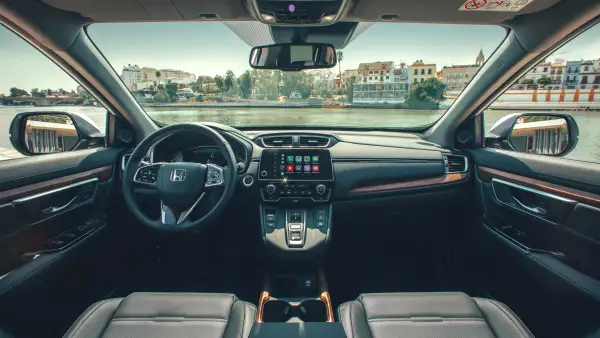
The Honda Connect multimedia system is quite awkward to use despite the large touch surfaces. Positive aspect: It is arranged in the middle and is easy to reach and read. And unlike the Civic, the CR-V has a classic rotary volume control. The air conditioning control panel does not pose any riddles, but the selected temperature is not shown directly on the buttons, but on the main display.
There are many very small buttons for operation, which are divided between the steering wheel and a switch area on the left behind the steering wheel and are therefore not optimally located in the driver’s field of vision. Annoyance is also caused by the fact that commands via finger touch are executed with a time delay.
Honda CR-V: Only subtle innovations
Most recently, Honda has refreshed the CR-V only very subtly. For example with the already mentioned e:HEV lettering, with darkened privacy glass on the Elegance and the wireless charging option for smartphones on the Executive. The Sport Line equipment line is new, but it is limited to visual refinements and has nothing to do with sportier driving performance. Except for the basic version called Comfort (from 35,000 euros), all variants are also available with all-wheel drive, for which Honda charges 2,100 euros each.
And for the sake of completeness: The top version Executive (from 47,600 euros) is only available with all-wheel drive. The Elegance variant with front-wheel drive tested by ADAC costs from 38,750 euros. It is unfortunate that the CR-V Hybrid is only of limited use as a towing vehicle. While the petrol engine was allowed to hook up to 1500 kilograms, the hybrid only weighs 750 kilograms.
Conclusion: Surprisingly economical for a large SUV
Anyone who does not want to use the Honda CR-V Hybrid as a towing vehicle and is not bothered by the occasional roar of the engine, nor by the space requirement and the confusion when parking, should like it. Relaxed cruising is his thing: arm out the window – and just let it go. Then the SUV is also very economical.
Honda CR-V Hybrid: specifications, price
| Technical data (manufacturer information) | Honda CR-V 2.0 i-MMD Hybrid Elegance 2WD e-CVT (from 07/20) |
|---|---|
| Engine type | Voll-Hybrid |
| Displacement (combustion engine) | 1.993 ccm |
| Maximum power in kW (system power) | 135 |
| Maximum power in HP (system power) | 184 |
| Torque (system power) | 315 Nm |
| Maximum power at rpm. (combustion engine) | 6.200 U/min |
| Drive type | Vorderrad |
| Acceleration 0-100km/h | 8,6 s |
| Top speed | 180 km/h |
| CO2 value combined (WLTP) | 151 g/km |
| Consumption combined (WLTP) | 6,6 l/100 km |
| Total consumption (NEDC) | 5,3 l/100 km |
| Trunk volume normal | 497 l |
| Roof-high trunk volume with the rear bench seat folded down | 1.692 l |
| Curb weight (EU) | 1.685 kg |
| payload | 555 kg |
| Trailer load unbraked | 600 kg |
| Trailer load braked 12% | 750 kg |
| warranty (vehicle) | 3 Jahre oder 100.000 km |
| length x WIDTH X HEIGHT | 4.600 mm x 1.855 mm x 1.679 mm |
| Basic price | 38.750 Euro |
ADAC Readings
| Abstract | Honda CR-V 2.0i-MMD Hybrid 2WD Elegance |
|---|---|
| Overtaking 60 – 100 km/h | 6,3 s |
| Braking distance from 100 km/h | 36,5 m |
| Turning circle | 11,9 m |
| Consumption / CO₂ emissions ADAC Ecotest | 7,0 l Super/100 km, 189 g CO₂/km (Well-to-wheel) |
| Rating ADAC Ecotest (max. 5 stars) | *** |
| Range | 810 km |
| Interior noise at 130 km/h | 68,3 dB(A) |
| Curb weight / payload | 1620 / 620 kg |
| Trunk volume normal / folded / roof high | 445 / 890 / 1560 l |
ADAC test result
Honda CR-V 2.0i-MMD Hybrid 2WD | |
|---|---|
| Body/trunk | 2,6 |
| inner space | 2,3 |
| Comfort | 2,8 |
| Engine/drive | 1,8 |
| Driving characteristics | 2,6 |
| Security | 2,0 |
| Environment/Ecotest | 3,3 |
| Overall score (2019 test) | 2,5 |
Editor’s advice; 2022 Honda CRV Hybrid Oil Change
